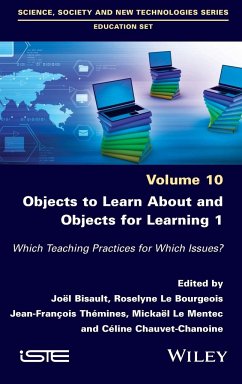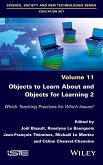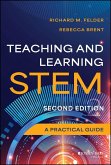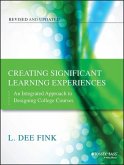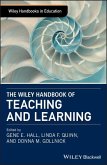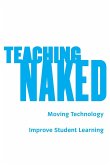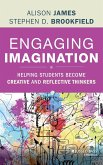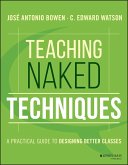Objects to Learn about and Objects for Learning 1
Which Teaching Practices for Which Issues?
Herausgegeben:Bisault, Joel; Le Bourgeois, Roselyne; Themines, Jean-Francois; Le Mentec, Mickael; Chauvet-Chanoine, Celine
Objects to Learn about and Objects for Learning 1
Which Teaching Practices for Which Issues?
Herausgegeben:Bisault, Joel; Le Bourgeois, Roselyne; Themines, Jean-Francois; Le Mentec, Mickael; Chauvet-Chanoine, Celine
- Gebundenes Buch
- Merkliste
- Auf die Merkliste
- Bewerten Bewerten
- Teilen
- Produkt teilen
- Produkterinnerung
- Produkterinnerung
Resulting from a conference that took place in Amiens, France, in June 2019, this book examines the place and role of objects centered in teaching practices from kindergarten to university, both in the context of France and elsewhere. These "objects for learning" are considered in their physicality as productions, work or signs that are used for learning. They become "objects to learn about" when the object itself is the learning objective.
This book offers a cross-disciplinary perspective, linking the different disciplinary fields studied and the many reference sources used by the authors.…mehr
Andere Kunden interessierten sich auch für
![Objects to Learn about and Objects for Learning 2 Objects to Learn about and Objects for Learning 2]() Objects to Learn about and Objects for Learning 2159,99 €
Objects to Learn about and Objects for Learning 2159,99 €![Teaching and Learning Stem Teaching and Learning Stem]() Richard M. FelderTeaching and Learning Stem50,99 €
Richard M. FelderTeaching and Learning Stem50,99 €![Creating Significant Learning Experiences Creating Significant Learning Experiences]() L. Dee FinkCreating Significant Learning Experiences47,99 €
L. Dee FinkCreating Significant Learning Experiences47,99 €![The Wiley Handbook of Teaching and Learning The Wiley Handbook of Teaching and Learning]() The Wiley Handbook of Teaching and Learning202,99 €
The Wiley Handbook of Teaching and Learning202,99 €![Teaching Naked Teaching Naked]() José Antonio BowenTeaching Naked35,99 €
José Antonio BowenTeaching Naked35,99 €![Engaging Imagination Engaging Imagination]() Alison JamesEngaging Imagination45,99 €
Alison JamesEngaging Imagination45,99 €![Teaching Naked Techniques Teaching Naked Techniques]() José Antonio BowenTeaching Naked Techniques29,99 €
José Antonio BowenTeaching Naked Techniques29,99 €-
-
-
Resulting from a conference that took place in Amiens, France, in June 2019, this book examines the place and role of objects centered in teaching practices from kindergarten to university, both in the context of France and elsewhere. These "objects for learning" are considered in their physicality as productions, work or signs that are used for learning. They become "objects to learn about" when the object itself is the learning objective.
This book offers a cross-disciplinary perspective, linking the different disciplinary fields studied and the many reference sources used by the authors. This two-volume work offers an overview of current research on the subject, with this first volume introducing the questions addressed and then going on to investigate the relationship between objects and languages, looking at objects at the heart of early learning.
This book offers a cross-disciplinary perspective, linking the different disciplinary fields studied and the many reference sources used by the authors. This two-volume work offers an overview of current research on the subject, with this first volume introducing the questions addressed and then going on to investigate the relationship between objects and languages, looking at objects at the heart of early learning.
Produktdetails
- Produktdetails
- Verlag: Wiley & Sons / Wiley-ISTE
- Artikelnr. des Verlages: 1W786306710
- 1. Auflage
- Seitenzahl: 240
- Erscheinungstermin: 19. April 2022
- Englisch
- Abmessung: 240mm x 161mm x 18mm
- Gewicht: 484g
- ISBN-13: 9781786306715
- ISBN-10: 1786306719
- Artikelnr.: 63396667
- Herstellerkennzeichnung
- Libri GmbH
- Europaallee 1
- 36244 Bad Hersfeld
- gpsr@libri.de
- Verlag: Wiley & Sons / Wiley-ISTE
- Artikelnr. des Verlages: 1W786306710
- 1. Auflage
- Seitenzahl: 240
- Erscheinungstermin: 19. April 2022
- Englisch
- Abmessung: 240mm x 161mm x 18mm
- Gewicht: 484g
- ISBN-13: 9781786306715
- ISBN-10: 1786306719
- Artikelnr.: 63396667
- Herstellerkennzeichnung
- Libri GmbH
- Europaallee 1
- 36244 Bad Hersfeld
- gpsr@libri.de
Joel Bisault is Emeritus Professor at the University of Picardie Jules Verne, France, and a member of the CAREF laboratory. His research focuses on science education in elementary school and on school objects. Roselyne Le Bourgeois is an honorary lecturer at the University of Picardie Jules Verne, France, and a member of the CAREF laboratory. Her research focuses on the teaching of history in relation to other fields from kindergarten to the end of elementary school. Jean-Francois Themines is a Professor at the University of Caen Normandy, France, and a researcher at the ESO laboratory. His research focuses on didactic approaches to the teaching of geography in secondary and higher education as well as the geography of educational inequalities. Mickael Le Mentec is a lecturer at the University of Picardie Jules Verne, France, and a member of the CAREF laboratory. His research focuses on the socio educational uses of digital technologies. Celine Chauvet-Chanoine is a school teacher and holds a doctorate in educational sciences from the CAREF laboratory of the University of Picardie Jules Verne, France. Her research focuses on science education in kindergarten, on school objects and on the professional identity of teachers.
Preface. From a Conference to a Book on the Role of Objects in the Practices of Teachers xi
Joël BISAULT, Roselyne LE BOURGEOIS, Jean-François THÉMINES, Mickaël LE MENTEC and Céline CHAUVET-CHANOINE
Acknowledgements xxi
Introduction. In the Teaching Resources Store Cupboard: Investigating the Functions and Uses of Objects in the World of School xxiii
Joël LEBEAUME
Introduction to the Subject. Didactics and Socialization Processes: Walking Between Objects, Things and Worlds xxxvii
Sylvain FABRE
Part 1 Objects and Language(s) 1
Chapter 1 The Children's Illustrated Literature Book in an Elementary School English Session: An Object Considered in its Materiality? 3
Élise OUVRARD
1.1 The origins of questioning and theoretical framing 3
1.2 Constitution of the corpus 6
1.3 Analysis of the results 7
1.3.1 The book-object in the classroom 7
1.3.2 A varied instrumentation of the picture book 9
1.3.3 Sense experience 13
1.3.4 Memory aids, objects of affection 15
1.4 Conclusion 17
1.5 References 18
Chapter 2 Objects as Catalysts for Writing 21
Bruno HUBERT
2.1 Introduction 21
2.2 The object, a mediator in self-knowledge 22
2.2.1 Bring your exercise books to teacher training 22
2.2.2 Personal items for writing at school in third and fourth grades 22
2.3 Objects as organizers of the act of writing in the Elementary Section 24
2.3.1 From handling objects to the entry into narrative 24
2.3.2 From concrete objects to objects of knowledge 26
2.3.3 An aid to representation 29
2.3.4 Writing, an object of interactions and desire 30
2.4 Conclusion 32
2.5 References 33
Chapter 3 The Role of Artifacts and Gestures in English Language Learning 35
Zehra GABILLON and Rodica AILINCAI
3.1 Introduction 35
3.2 Theoretical background 36
3.2.1 The CLIL approach 37
3.2.2 Theoretical position 38
3.2.3 Issues and assumptions 40
3.3 Methodology 41
3.3.1 Characteristics of the population 42
3.3.2 Characteristics and content of activities 42
3.3.3 Data collection 44
3.3.4 Methods of data analysis 44
3.4 Results 46
3.5 Discussion 54
3.6 Conclusion 55
3.8 References 56
Chapter 4 From Object to Instrument for Language Development in Kindergarten: Necessary Support in the Development of Professional Competence Among Probationary Public School Teachers 61
Émilie MAGNAT and Karima OLECHNY
4.1 Introduction 61
4.2 From object to instrument for language in kindergarten 62
4.2.1 From educational object to instrument 62
4.2.2 A consideration of objects, a key stage in the training of school teachers 65
4.3 Learning objects: Speech instruments for teacher and pupils 71
4.3.1 Support that determines awareness among probationary school teachers 71
4.3.2 On the effect of object-instruments on pupils' speech 74
4.4 Conclusion and perspectives 76
4.5 References 77
Chapter 5 Professional Testimony: Construction and Analysis of a "Graphic Object" in a Physics Class in a 12th Grade Science Major 79
Laurent MOUTET
5.1 Introduction 79
5.2 Description of the second pilot sequence 80
5.2.1 Context of the activity 80
5.2.2 Handout distributed to the pupils 81
5.2.3 Construction of the "graphic object" of the situation 81
5.2.4 A priori analysis of the sequence 85
5.2.5 A posteriori analysis of the sequence 86
&
Joël BISAULT, Roselyne LE BOURGEOIS, Jean-François THÉMINES, Mickaël LE MENTEC and Céline CHAUVET-CHANOINE
Acknowledgements xxi
Introduction. In the Teaching Resources Store Cupboard: Investigating the Functions and Uses of Objects in the World of School xxiii
Joël LEBEAUME
Introduction to the Subject. Didactics and Socialization Processes: Walking Between Objects, Things and Worlds xxxvii
Sylvain FABRE
Part 1 Objects and Language(s) 1
Chapter 1 The Children's Illustrated Literature Book in an Elementary School English Session: An Object Considered in its Materiality? 3
Élise OUVRARD
1.1 The origins of questioning and theoretical framing 3
1.2 Constitution of the corpus 6
1.3 Analysis of the results 7
1.3.1 The book-object in the classroom 7
1.3.2 A varied instrumentation of the picture book 9
1.3.3 Sense experience 13
1.3.4 Memory aids, objects of affection 15
1.4 Conclusion 17
1.5 References 18
Chapter 2 Objects as Catalysts for Writing 21
Bruno HUBERT
2.1 Introduction 21
2.2 The object, a mediator in self-knowledge 22
2.2.1 Bring your exercise books to teacher training 22
2.2.2 Personal items for writing at school in third and fourth grades 22
2.3 Objects as organizers of the act of writing in the Elementary Section 24
2.3.1 From handling objects to the entry into narrative 24
2.3.2 From concrete objects to objects of knowledge 26
2.3.3 An aid to representation 29
2.3.4 Writing, an object of interactions and desire 30
2.4 Conclusion 32
2.5 References 33
Chapter 3 The Role of Artifacts and Gestures in English Language Learning 35
Zehra GABILLON and Rodica AILINCAI
3.1 Introduction 35
3.2 Theoretical background 36
3.2.1 The CLIL approach 37
3.2.2 Theoretical position 38
3.2.3 Issues and assumptions 40
3.3 Methodology 41
3.3.1 Characteristics of the population 42
3.3.2 Characteristics and content of activities 42
3.3.3 Data collection 44
3.3.4 Methods of data analysis 44
3.4 Results 46
3.5 Discussion 54
3.6 Conclusion 55
3.8 References 56
Chapter 4 From Object to Instrument for Language Development in Kindergarten: Necessary Support in the Development of Professional Competence Among Probationary Public School Teachers 61
Émilie MAGNAT and Karima OLECHNY
4.1 Introduction 61
4.2 From object to instrument for language in kindergarten 62
4.2.1 From educational object to instrument 62
4.2.2 A consideration of objects, a key stage in the training of school teachers 65
4.3 Learning objects: Speech instruments for teacher and pupils 71
4.3.1 Support that determines awareness among probationary school teachers 71
4.3.2 On the effect of object-instruments on pupils' speech 74
4.4 Conclusion and perspectives 76
4.5 References 77
Chapter 5 Professional Testimony: Construction and Analysis of a "Graphic Object" in a Physics Class in a 12th Grade Science Major 79
Laurent MOUTET
5.1 Introduction 79
5.2 Description of the second pilot sequence 80
5.2.1 Context of the activity 80
5.2.2 Handout distributed to the pupils 81
5.2.3 Construction of the "graphic object" of the situation 81
5.2.4 A priori analysis of the sequence 85
5.2.5 A posteriori analysis of the sequence 86
&
Preface. From a Conference to a Book on the Role of Objects in the Practices of Teachers xi
Joël BISAULT, Roselyne LE BOURGEOIS, Jean-François THÉMINES, Mickaël LE MENTEC and Céline CHAUVET-CHANOINE
Acknowledgements xxi
Introduction. In the Teaching Resources Store Cupboard: Investigating the Functions and Uses of Objects in the World of School xxiii
Joël LEBEAUME
Introduction to the Subject. Didactics and Socialization Processes: Walking Between Objects, Things and Worlds xxxvii
Sylvain FABRE
Part 1 Objects and Language(s) 1
Chapter 1 The Children's Illustrated Literature Book in an Elementary School English Session: An Object Considered in its Materiality? 3
Élise OUVRARD
1.1 The origins of questioning and theoretical framing 3
1.2 Constitution of the corpus 6
1.3 Analysis of the results 7
1.3.1 The book-object in the classroom 7
1.3.2 A varied instrumentation of the picture book 9
1.3.3 Sense experience 13
1.3.4 Memory aids, objects of affection 15
1.4 Conclusion 17
1.5 References 18
Chapter 2 Objects as Catalysts for Writing 21
Bruno HUBERT
2.1 Introduction 21
2.2 The object, a mediator in self-knowledge 22
2.2.1 Bring your exercise books to teacher training 22
2.2.2 Personal items for writing at school in third and fourth grades 22
2.3 Objects as organizers of the act of writing in the Elementary Section 24
2.3.1 From handling objects to the entry into narrative 24
2.3.2 From concrete objects to objects of knowledge 26
2.3.3 An aid to representation 29
2.3.4 Writing, an object of interactions and desire 30
2.4 Conclusion 32
2.5 References 33
Chapter 3 The Role of Artifacts and Gestures in English Language Learning 35
Zehra GABILLON and Rodica AILINCAI
3.1 Introduction 35
3.2 Theoretical background 36
3.2.1 The CLIL approach 37
3.2.2 Theoretical position 38
3.2.3 Issues and assumptions 40
3.3 Methodology 41
3.3.1 Characteristics of the population 42
3.3.2 Characteristics and content of activities 42
3.3.3 Data collection 44
3.3.4 Methods of data analysis 44
3.4 Results 46
3.5 Discussion 54
3.6 Conclusion 55
3.8 References 56
Chapter 4 From Object to Instrument for Language Development in Kindergarten: Necessary Support in the Development of Professional Competence Among Probationary Public School Teachers 61
Émilie MAGNAT and Karima OLECHNY
4.1 Introduction 61
4.2 From object to instrument for language in kindergarten 62
4.2.1 From educational object to instrument 62
4.2.2 A consideration of objects, a key stage in the training of school teachers 65
4.3 Learning objects: Speech instruments for teacher and pupils 71
4.3.1 Support that determines awareness among probationary school teachers 71
4.3.2 On the effect of object-instruments on pupils' speech 74
4.4 Conclusion and perspectives 76
4.5 References 77
Chapter 5 Professional Testimony: Construction and Analysis of a "Graphic Object" in a Physics Class in a 12th Grade Science Major 79
Laurent MOUTET
5.1 Introduction 79
5.2 Description of the second pilot sequence 80
5.2.1 Context of the activity 80
5.2.2 Handout distributed to the pupils 81
5.2.3 Construction of the "graphic object" of the situation 81
5.2.4 A priori analysis of the sequence 85
5.2.5 A posteriori analysis of the sequence 86
&
Joël BISAULT, Roselyne LE BOURGEOIS, Jean-François THÉMINES, Mickaël LE MENTEC and Céline CHAUVET-CHANOINE
Acknowledgements xxi
Introduction. In the Teaching Resources Store Cupboard: Investigating the Functions and Uses of Objects in the World of School xxiii
Joël LEBEAUME
Introduction to the Subject. Didactics and Socialization Processes: Walking Between Objects, Things and Worlds xxxvii
Sylvain FABRE
Part 1 Objects and Language(s) 1
Chapter 1 The Children's Illustrated Literature Book in an Elementary School English Session: An Object Considered in its Materiality? 3
Élise OUVRARD
1.1 The origins of questioning and theoretical framing 3
1.2 Constitution of the corpus 6
1.3 Analysis of the results 7
1.3.1 The book-object in the classroom 7
1.3.2 A varied instrumentation of the picture book 9
1.3.3 Sense experience 13
1.3.4 Memory aids, objects of affection 15
1.4 Conclusion 17
1.5 References 18
Chapter 2 Objects as Catalysts for Writing 21
Bruno HUBERT
2.1 Introduction 21
2.2 The object, a mediator in self-knowledge 22
2.2.1 Bring your exercise books to teacher training 22
2.2.2 Personal items for writing at school in third and fourth grades 22
2.3 Objects as organizers of the act of writing in the Elementary Section 24
2.3.1 From handling objects to the entry into narrative 24
2.3.2 From concrete objects to objects of knowledge 26
2.3.3 An aid to representation 29
2.3.4 Writing, an object of interactions and desire 30
2.4 Conclusion 32
2.5 References 33
Chapter 3 The Role of Artifacts and Gestures in English Language Learning 35
Zehra GABILLON and Rodica AILINCAI
3.1 Introduction 35
3.2 Theoretical background 36
3.2.1 The CLIL approach 37
3.2.2 Theoretical position 38
3.2.3 Issues and assumptions 40
3.3 Methodology 41
3.3.1 Characteristics of the population 42
3.3.2 Characteristics and content of activities 42
3.3.3 Data collection 44
3.3.4 Methods of data analysis 44
3.4 Results 46
3.5 Discussion 54
3.6 Conclusion 55
3.8 References 56
Chapter 4 From Object to Instrument for Language Development in Kindergarten: Necessary Support in the Development of Professional Competence Among Probationary Public School Teachers 61
Émilie MAGNAT and Karima OLECHNY
4.1 Introduction 61
4.2 From object to instrument for language in kindergarten 62
4.2.1 From educational object to instrument 62
4.2.2 A consideration of objects, a key stage in the training of school teachers 65
4.3 Learning objects: Speech instruments for teacher and pupils 71
4.3.1 Support that determines awareness among probationary school teachers 71
4.3.2 On the effect of object-instruments on pupils' speech 74
4.4 Conclusion and perspectives 76
4.5 References 77
Chapter 5 Professional Testimony: Construction and Analysis of a "Graphic Object" in a Physics Class in a 12th Grade Science Major 79
Laurent MOUTET
5.1 Introduction 79
5.2 Description of the second pilot sequence 80
5.2.1 Context of the activity 80
5.2.2 Handout distributed to the pupils 81
5.2.3 Construction of the "graphic object" of the situation 81
5.2.4 A priori analysis of the sequence 85
5.2.5 A posteriori analysis of the sequence 86
&

